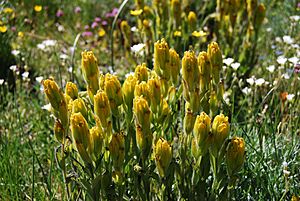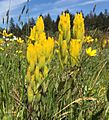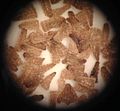Golden paintbrush facts for kids
Quick facts for kids Golden paintbrush |
|
|---|---|
 |
|
| Conservation status | |
| Scientific classification | |
| Genus: |
Castilleja
|
| Species: |
levisecta
|
Castilleja levisecta is a special flowering plant often called the golden paintbrush or golden Indian paintbrush. It's a very rare species, and because of this, it was listed as an endangered species in the United States in 1997. It's also considered endangered in Canada. This plant is naturally found in parts of British Columbia and Washington. Sadly, it used to grow in Oregon, but all its natural groups there have disappeared. Scientists are trying to bring it back to Oregon by planting it in new areas.
Contents
About the Golden Paintbrush
The golden paintbrush was first found in Washington in 1880. It's a perennial herb, meaning it lives for more than two years. It grows in clumps with up to fifteen stems. Its leaves are green and contain chlorophyll, which helps them make food using sunlight through photosynthesis.
How it Gets Nutrients
Like other Castilleja plants, the golden paintbrush is a hemiparasite. This means it can connect to the roots of other plants. By doing this, it gets extra nutrients and water, helping it grow strong.
Appearance and Pollination
The plant has bright golden yellow bracts. These are like special leaves that surround the small green flowers. It's the only Castilleja plant in the Pacific Northwest with yellow bracts. Bumblebees, like the Bombus californicus, are thought to help pollinate this plant. This means they carry pollen from one flower to another, helping the plant make seeds. The golden paintbrush usually produces more seeds when it gets pollen from a plant that is not closely related.
Where the Golden Paintbrush Lives
This plant grows in prairie areas that are not very high up. It prefers soils that are gravelly and were shaped by glaciers. You can often find it growing near Idaho fescue and red fescue grasses. It's an important part of the Garry Oak ecosystem.
Current Locations
In Canada, the golden paintbrush is found on Trial Island and Alpha Islet, which are off Vancouver Island. In Washington, there are nine groups of these plants. They live in grasslands and bluffs near the Puget Sound. Many of these groups are on islands, including Whidbey Island and San Juan Island.
Challenges and Conservation Efforts
The grasslands where the golden paintbrush lives sometimes have wildfires. The plant seems to do well after fires. This might be because fires clear out taller plants that would compete with it. Fires can also add nutrients to the soil from ash. If the plant needs fire, then efforts to stop fires could actually harm it.
Threats to the Plant
Other dangers to the golden paintbrush include:
- Habitat destruction: When land is used for homes or other buildings.
- New plant species: Plants like mouse-ear hawkweed, Scotch broom, and oxeye daisy can take over its space.
- Animals eating it: Wild animals sometimes eat the plants.
- People walking on them: Hikers can accidentally step on and damage the plants.
- Picking: Some people pick the flowers, which reduces the number of plants.
Working to Protect the Species
Even though it's rare, the golden paintbrush has a lot of different genes. This is good because it makes the plant less likely to disappear quickly. People are working hard to save this species. They are trying to grow more plants and put them into suitable habitats. They are also planting more individuals in areas where the plant already exists. The plant has been brought back to the Willamette Valley in Oregon, where it used to grow. Scientists will watch these new groups for many years to make sure they are healthy and surviving.
Images for kids
-
Bright yellow bracts of Castilleja levisecta are more tightly pressed against the stem than bracts of many other Castilleja species




